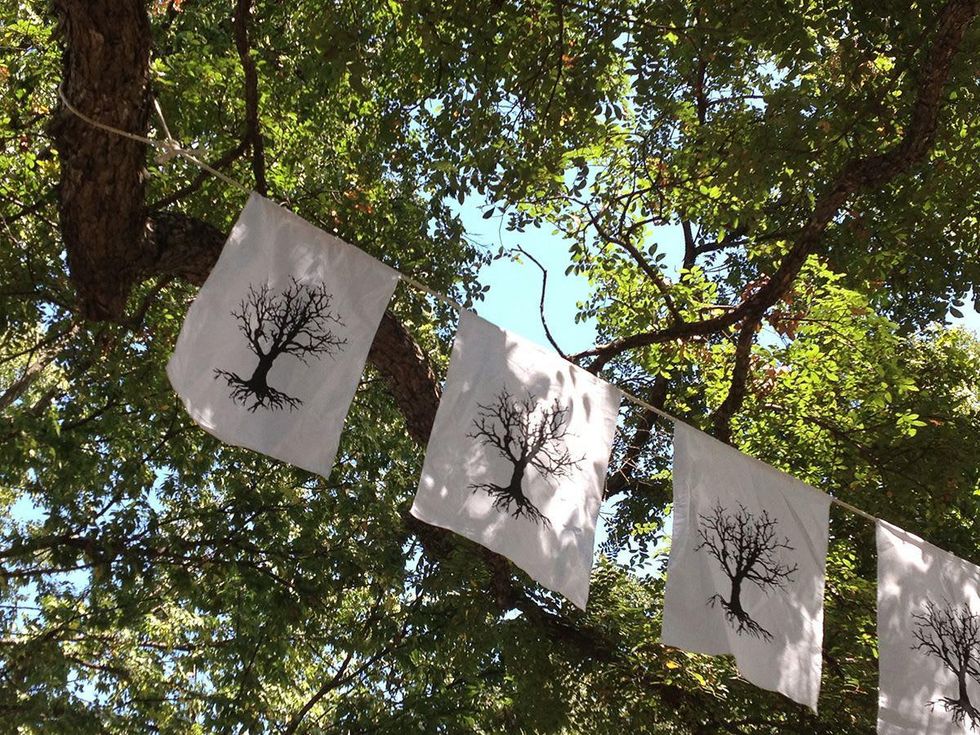Public THIRST on Lady Bird Lake
A first look at massive art project on Lady Bird Lake
Starting next weekend, you won’t be able to run, kayak or even simply admire our sparkling Town Lake without thinking about dead trees. At least that’s how Women & Their Work gallery hopes people will respond to new art piece THIRST. The temporary, large-scale installation is meant to engage Austinites, visually and powerfully, on the matter of water — our most precious, scarcest resource.
The installation, which will be unveiled September 29, features a dead, 35-foot-tall cedar elm tree (yep, it’s a real dead tree), painted ghostly white, hovering over the surface of Lady Bird Lake between the Pfluger Pedestrian and Lamar bridges. Fourteen thousand Tibetan-style prayer flags — wistful white squares silkscreened with that central, spectral image — will be strung from trees in a 2.5-mile loop through the hike-and-bike trail, from the Lamar Bridge to the First Street Bridge and back.
The Colorado River has seen better, wetter years. Since 2011 — the driest year on record since 1954, averaging only 14.8 inches of rainfall — our whole state has been suffering through a prolonged drought. Lake inflows are the lowest in history, and Central Texas reservoirs are only 34 percent full. Lake Travis is more than 60 feet lower than it should be.
Yet the water level of Lady Bird Lake — the geographical and emotional center of Austin — never wavers. It's kept constant by two dams: The Longhorn Dam on the eastern end and the Tom Miller Dam on the west. It’s an easy place to be complacent about the availability of water in our lives. As THIRST Team visual artist and UT art professor Beili Liu explains, “sometimes it is exactly the place we tend to forget about the urgency of the water crisis.” THIRST hopes to challenge that attitude and focus Austin’s attention on conserving and preserving, while also serving as a memorial for the more than 300 million trees that died in Texas in the 2011 drought.
Norma Yancey, a THIRST Team artist, is a Clayton & Little architect whose work rehabilitating historic buildings for modern-day function involves weaving the worlds of art and architecture, skillfully inserting new elements into the existing, built environment. She explains the THIRST vision of using Town Lake as a powerful platform for initiating community conversation and bringing about change: “The team and I quickly realized that the simple act of watering a tree wouldn’t undo or prevent a drought. A small team of artists had the means to make a big statement.”
Those means came via a $50,000 Artistic Innovation and Collaboration grant from the Robert Rauschenberg Foundation, a New York-based organization that supports innovative collaborations in the spirit of the famous artist. THIRST was one of nine projects in the country (and the only one in Texas) to be chosen for funding from a nationwide competition, a selection that reinforces the idea of Austin as a place of artistic innovation and creativity. Rauschenberg believed "art can change the world,” explains Women & Their Work Executive Director Chris Cowden, “It is to this high standard that THIRST aspires."
THIRST is a free piece of collaborative, public art that will be installed September 29 and remain on view through December 20. For more information, including ways to volunteer or donate to THIRST, visit here.




 Asian vendors gathered for Tayo Na launch part, which celebrated the area's
Asian vendors gathered for Tayo Na launch part, which celebrated the area's  Asian Season ATX celebrates Asian Heritage Month at Austin Beerworks.Photo by Joi Conti Photography
Asian Season ATX celebrates Asian Heritage Month at Austin Beerworks.Photo by Joi Conti Photography